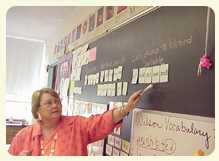


![]()
The Hope team expanded its membership by bringing in more staff, parents and community members to the first summer professional development institute. Prior to this, the Hope team implemented the goals-setting activity in the school and collaboratively developed school goals emphasizing literacy, a nurturing environment for students, and parent involvement in school efforts.
At the institute, Hope’s team used their school goals as a framework within which to review a fictional school. AED facilitators set up a simulation of a review in which participants—organized in teams of 8 to 10—reviewed student work and “visited” classrooms (observed videotapes) for evidence that the fictional school under review was addressing its teaching and learning goals.
The teams worked under the guidance of a senior reviewer, discussed and weighed evidence, resolved differences of opinion, and developed a collective perspective on how well the school was fulfilling its goals.

The teams then wrote a report to mirror a school back to itself. They also posed questions for reflection to the school, which urged it to consider how it could address its goals by building on the resources that already existed within the school. At all times, AED facilitators urged review teams to adopt a constructive tone so that the school would find the report useful, without being prescriptive. A good report, AED senior reviewers advised, lets a school know that the team has “gotten” the school; if the team has not done so, the report will not be useful.

